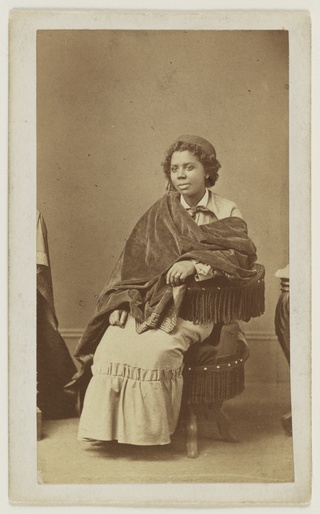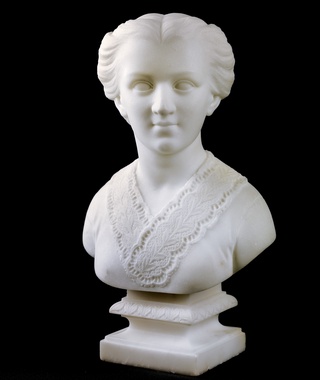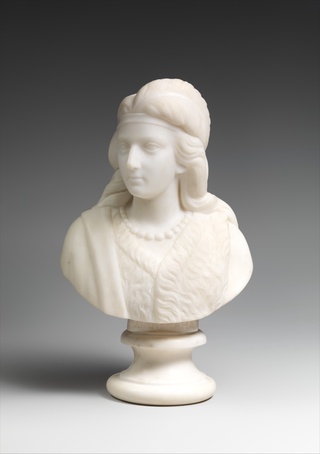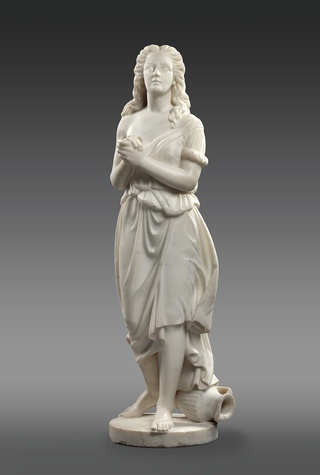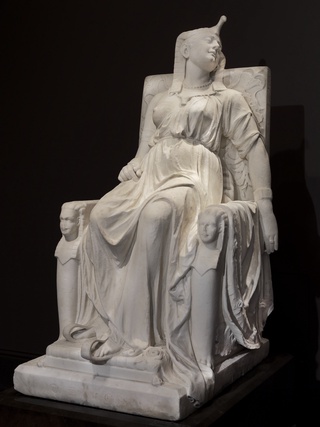Women Artists, Modernity, and Modernism
By Reina Gattuso•August 2024•26 Minute Read
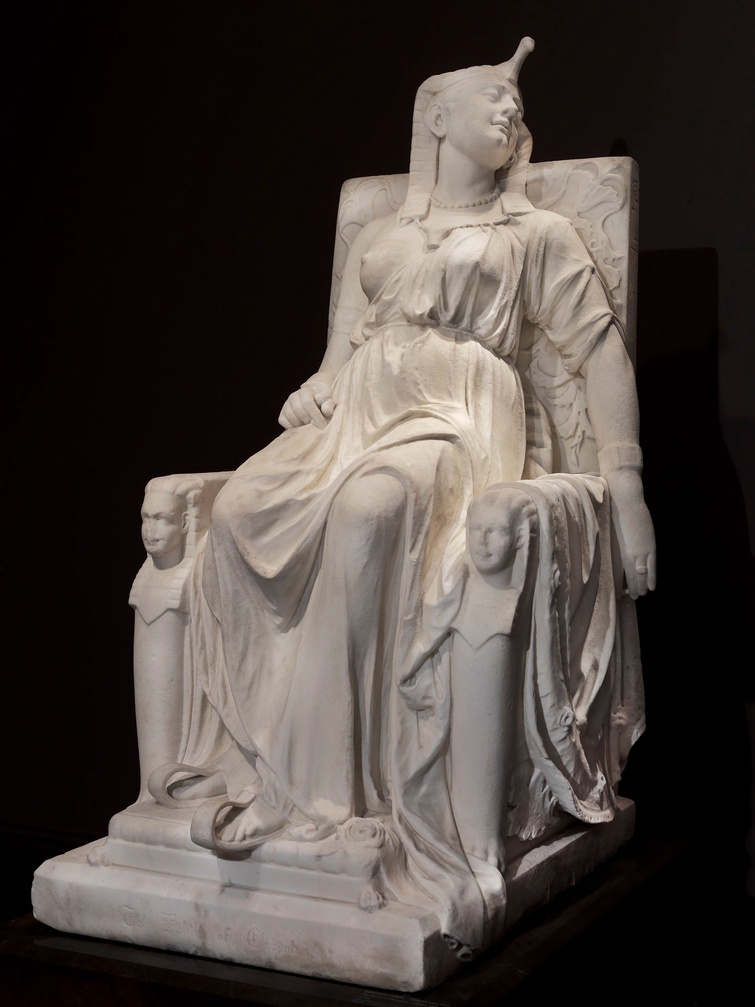
Edmonia Lewis, born Greenbush (now Rensselaer), NY, 1844-died London, England 1907. The Death of Cleopatra, carved 1876, Smithsonian American Art Museum, Smithsonian Institution. CC0.
The 19th and early 20th centuries witnessed seismic economic and political shifts. As the growth of capitalist markets and the rise of new technologies helped spread aesthetic movements, women from diverse contexts found ways to participate in public artmaking.
In the 19th and early 20th centuries, the global expansion of capitalism alongside European colonialism created new opportunities and challenges for women artists.
Women were part of the large-scale migrations of workers to industrializing cities, where they encountered vibrant urban cultures, as well as violence and discrimination.1 New technologies, such as the telegraph and railroads, enabled faster global travel and communication. This allowed artists and aesthetic movements to spread and cross-pollinate more rapidly than ever before.2 Scholars broadly refer to these social, economic, and political changes as modernization, and the resulting cultural movements as modernism.3
Artists across the world engaged with modernization in different ways, resulting in multiple, intersecting modernist movements. Common threads across these diverse creative traditions included an emphasis on formal experimentation and self-expression.4 Artists from places colonized by European nations, or from racially marginalized groups in the Global North, often channeled this aesthetic experimentation into an antiracist and anticolonial assertion of cultural identity.
While many women artists, whether in the Global North or South, still worked under the direction of their male relatives—a common practice for centuries—they increasingly forged opportunities to support themselves by making and selling art in their own names. Women began making inroads into art schools, despite these institutions’ sexist admissions policies.5
Male and white gatekeepers frequently minimized the significance of women’s artistic contributions. Contemporary feminist and postcolonial scholars have pushed back on this erasure. They have recentered 19th- and early 20th-century women artists’ work both as significant in and of itself and as vital to the worldwide development of diverse artistic modernisms.6
Working from different geographic and social locations, each of the artists in this feature—Katsushika Ōi, Edmonia Lewis, and María Izquierdo—fought patriarchal and often racist constraints to forge strong creative visions that critically engaged with modernity.
Katsushika Ōi: From Edo to Tokyo
Katsushika Ōi worked in the genre of ukiyo-e block prints and painted silks. Ukiyo-e depicted vibrant scenes from the thriving popular culture of 19th-century urban Japan. Ōi’s life and work coincided with the last years of the isolationist Edo period.7 Ōi, who died in 1866, lived in the city of Edo at the cusp of its transformation into modern-day Tokyo. Scholars often mark this period as the beginning of Japanese modernity. The culture of the era, including Ōi’s work, went on to have an outsize effect on the formation of Japanese and global modernisms.8
Katsushika Ōi trained under, lived with, and collaborated with her artist father, Katsushika Hokusai. She briefly married and moved in with a male artist before divorcing him and returning to live and work with her father. While Ōi’s sisters also assisted their father before marriage, Ōi remained his long-term collaborator.
Like many historical women artists, who often worked under more famous male relatives, it is difficult for contemporary art historians to identify which elements or works of Hokusai’s are actually in Ōi’s hand.9 However, art historians have identified some joint works. Ōi collaborated with Hokusai on his Self-Portrait as a Fisherman. It is part of a genre called surimono, designating works printed for private special occasions that include both an image and a poem.
There is a small body of work known to have been made by Ōi independently, including this visceral illustration of an operation. The painting depicts a scene from the Chinese novel, The Romance of the Three Kingdoms, in which military leader Guan Yu undergoes a bloodletting procedure. The density of the figures and their expressive gestures add tension to the scene. Ōi used bright reds to amplify the gory procedure with its vivid splatters of blood.
Some Edo-era women artists had aristocratic lineages and worked in the literati style favored by bureaucrats and intellectuals.10 In contrast, Ōi and Hokusai came from an artisan lineage.11 Ōi’s prints depart from serene nature to include striking elements of eroticism (as in the following illustration of an Edo brothel) and even violence, depicted through dramatic compositions and moody plays of light and shadow.
Katsushika Ōi, Courtesans Showing Themselves to the Strollers through the Grille, ca. 1818-1860. Õta Memorial Museum of Art. In this painting of courtesans in a pleasure quarter, lamplight and shadows spill upon backlit figures standing on a street.
Ōi’s contemporaries recognized her talent during her life. Edo artist Keisai Eisen commented that she “is skilled at drawing, and following after her father has become a professional artist while acquiring a reputation as a talented painter.”12 Yet art historians have frequently overlooked Ōi in favor of her male peers. According to art writer Max Levin, writing for Curationist, “Her relative disappearance from the art historical record ought to push contemporary viewers and scholars to reconsider female agency and artistic innovation during the Edo period.”13
Following Japan’s coerced opening to foreign trade in the late 19th century, European artists and collectors developed a popular market for Japanese art, part of a trend called japonisme. Japonisme often included European artists’ use of Orientalist tropes. Yet European artists also took serious inspiration from their Japanese colleagues’ use of color and form.14 French Impressionists were particularly inspired by ukiyo-e, and were enamored with Hokusai. While records are scarce, it’s likely that this included his collaborative work with Ōi. Inspired by ukiyo-e, artists like Mary Cassatt began incorporating flat, bounded blocks of color into their prints, as opposed to a more traditional European use of shading.15
A generation after Ōi, in 1893, a group of 44 Japanese women artists showed their work at the Chicago World’s Fair. The event was the culmination of Japanese state investment in art institutions, and women’s art education in particular, as well as increasing Western fervor for Japanese art.16 While the exhibition illustrated the emergence of Japanese women artists in the Western-dominated global art market, it also pointed to ongoing patriarchal limitations: Japanese officials barred women artists from the country’s “Fine Arts” pavilion, relegating them to the “Women’s Pavilion” instead.17 Arguably, this curatorial separation of “women’s art” from “art” as a broader category persists today.18
Regardless of this pointed exclusion, scholars Deborah Cherry and Janice Helland argue that the event represented one of several “many-faceted global encounters” that characterized the emergence of modernity in the 19th-century art world.19 Ōi, living under Meiji travel restrictions a generation before, was not able to access travel abroad. But an increasing body of research on Ōi continues to uncover how mobile her influence ultimately proved.
Edmonia Lewis: Sculpting Freedom
Edmonia Lewis was a sculptor who primarily created lifesize neoclassical marble works. Born free in upstate New York in 1844, and living most of her adult life in Rome, Italy, Lewis’s life and career spanned the period of slavery to Reconstruction to Jim Crow. Lewis was of Black and Native American ancestry.20 As a child, she helped her mother, who was likely of Ojibwe descent, make and sell souvenirs to tourists.21 In her adult work, Lewis often chose to depict Native Americans as well as themes related to Emancipation.
Neoclassical sculptors favored idealized human forms and ancient Greek and Roman references. While artists claimed their tradition was timeless, they actually used mythic references to communicate contemporary concerns about race and gender. Lewis’s peers, as well as subsequent art historians, often treated her race and gender as a “problem,” because she deviated from the Neoclassical ideal of the artist as a white man.22
These critics, like most people in the 19th-century United States, falsely believed race to be an innate biological characteristic that could be visually discerned through physical traits. In actuality, race is a hierarchical social system that white supremacist society projects onto the human body, through both material inequalities and cultural beliefs. Neoclassical sculptors contributed to racial constructions by depicting physical features associated with European people as “ideals” of beauty and purity. Indeed, cultural elites came to consider white marble itself as synonymous with both pale skin and the ideology of whiteness.23
We can see the violent process of racialization in the demeaning and brutal ways many of Lewis’s contemporaries treated her. While a student at the supposedly progressive and abolitionist Oberlin College, Lewis was accused of poisoning two white female students, accusations undoubtedly motivated by racism. A white mob used the accusations as an excuse to beat and sexually humiliate Lewis.24 Shortly after, she was accused of stealing art supplies and had to leave Oberlin without her degree.25
After moving to Boston, Lewis drew on a wide network of both Black and white abolitionist patrons to fund her art. She sculpted some of these patrons, including Anna Quincey Waterston. Many of Lewis’s white women patrons frequently discouraged her and disparaged her work. For example, noted abolitionist Lydia Maria Child often infantilized Lewis in letters to and about her. Child actively discouraged Lewis from pursuing more ambitious projects, withholding resources as a way to control the younger Black artist.26 Lewis defied this sabotage to become a successful sculptor.
One of the first works Lewis created upon moving to Rome was this bust of Minnehaha, completed in 1868. Lewis went on to produce and sell many copies of the bust.27 Minnehaha is a character from U.S. poet Henry Wadsworth Longfellow’s The Song of Hiawatha, which tells the tragic story of Hiawatha and Minnehaha, lovers from different Native American tribes. (Lewis also sculpted a portrait bust of Longfellow.) Longfellow based the epic poem on a white anthropologist’s retelling of an Ojibwe story.28
At the end of the poem, Minnehaha dies, while Hiawatha departs forever westward.29 Art historian Kristen Buick argues that this tragic ending staged the “myth of the vanishing Indian,” a white supremacist belief that the colonial genocide of Native Americans was inevitable. As part of this racist belief system, settler Amercans have often used images of Native Americans to symbolize U.S. national identity—while killing and displacing actual Native people.30
Buick argues that Lewis tended to talk about her own childhood among her mother’s community in idealized terms. In doing so, Lewis portrayed herself as even more authentically American than her white peers, since she was both Native and able to navigate Western elite culture.31 Similarly, Lewis imagined Minnehaha with both the typical facial features of Neoclassical sculpture, which viewers would have associated with European identity, as well as dress and accessories connoting “authentic” Native identity. Indeed, 19th century reviewers often equated Lewis’s identity with Minnehaha, with one critic commenting, “No happier illustrations of Longfellow’s most original poem were ever made than these by the Indian sculptor.”32
Edmonia Lewis, Forever Free, 1867. Howard University Gallery of Art, Washington, D.C. Photograph Steven Zucker for Smarthistory. Flickr, CC BY-NC-SA 2.0. Lewis’s allegory of Emancipation differs from other sculptures from the same time period in that it presents Black people as active agents of freedom rather than passive recipients of white charity.
Lewis similarly used idealized figures to comment on slavery and freedom. In her sculpture commemorating Emancipation, Forever Free, Lewis depicted a Black man standing with his hand resting on the shoulder of a kneeling woman. This triumphant posture portrays the man independently seizing freedom, in contrast to many white-authored images that depicted Emancipation as a gift white authorities gave to Black people. Buick interprets the gendered composition as celebrating Black people’s newfound right to marry, and the belief that Black men needed to serve as patriarchal protectors to Black women.33
Lewis’s sculpture of the biblical heroine Hagar, an enslaved Egyptian woman, presents another metaphor for Emancipation. When Old Testament matriarch Sarah realized she couldn’t have children, she “gifted” Hagar to her husband Abraham. After Hagar bore Abraham’s child, Sarah grew jealous and cast her into the desert. Hagar wandered, resigning herself and her child to death by dehydration, until an angel pointed her to a divine well. Art historian Charmaine Nelson argues that for Lewis, Hagar’s African origin, enslaved status, and treatment as a sexual object—as well as her ultimate salvation—would have all held poignant symbolism.34
Lewis’s Cleopatra similarly embodies the complexities of late 19th-century U.S. racial and gender politics. Following Napoleon’s invasion of Egypt, colonial archaeologists intensively excavated ancient Egyptian sites, leading to the rise of Orientalist Egyptomania. Dominant U.S. culture, which idealized female domesticity and chastity and equated these traits with whiteness, depicted Cleopatra as a racialized symbol of unrestrained sensuality. In contrast, many abolitionists claimed Cleopatra as a symbol of political power, part of a budding pan-Africanism that cast a majestic ancient Egypt as a forebear to contemporary Black America.35
Lewis depicted Cleopatra in the moment of suicide, after she is captured by the Romans. Buick argues Lewis connected Cleopatra’s choice of death over captivity with African American women’s continued struggle for freedom.36 Lewis based the queen’s visage on images from ancient Roman coin portraits rather than giving her facial features 19th-century viewers associated with African Americans. Nelson argues that in using Neoclassical conventions in this way, Lewis embraced Cleopatra as an ancestor to African Americans, while refusing white viewers’ desire to map the queen’s supposed sexual excess onto Black women’s bodies.37
The aesthetics of neoclassical sculpture appear very far from modernism’s emphasis on aesthetic experimentation. Yet art historian Judith Wilson argues that, in choosing to sculpt Cleopatra and Hagar, Lewis demonstrated a nascent “international black consciousness” that contributed to the development of modernism. Wilson claims Lewis as a “non-canonical” modernist foremother.38 Lewis’s works were thus both profoundly meaningful in and of themselves, and expanded the representational possibilities of Western art.
María Izquierdo: Mexican Modernism and Arte Puro
From the 1930s to the 50s, María Izquierdo was one of the most well-known Mexican artists. Galleries in Mexico and abroad presented at least 20 solo shows of Izquierdo’s work in her lifetime.39 She crafted a modernist vision of Mexican art that centered the daily lives of women and their relationship to the land.
Izquierdo’s Work in Museum Archives
As of 2023, none of Curationist’s partner collections hold Izquierdo’s work. Images in this section are mostly from the Florence Arquin slide collection at Florida Atlantic University.
Arquin was a U.S. photographer who was part of Mexican modernist circles. Artists like Izquierdo, as well as dealers like María Asúnsolo, frequently invited Arquin to photograph their work. Arquin often brought the works into the sunlight to photograph. Emily Fenichel, Florida Atlantic University professor and Arquin Slide Collection Co-Director, speculates this was to enhance the vibrancy of the photographs.40 The resulting images stage Izquierdo’s work against the physical and social backdrop of 1940s and 50s Mexico City, and present a dialogue between the two artists.
Florence Arquin, Photograph of María Izquierdo’s “Autorretrato,” undated. The Arquin Slide Collection, copyright undetermined. Arquin, an American photographer, documented the works of many Mexican modernists, including this photograph of María Izquierdo’s Self-Portrait.
For example, Arquin chose to stage Izquierdo’s Self-Portrait, in which Izquierdo paints herself sitting on a wood chair with a straw seat, on a very similar if not identical chair. The painting’s window appears to open up onto the real sky of the photograph and the gray wall in the painting echoes the photographer's gray cement background.
Izquierdo, Gender, and Mexican Nationalism
Izquierdo largely produced easel paintings like Self-Portrait, illustrating themes from daily life, often including women, domestic practices, and agricultural landscapes, tinged with surreal or fantastic elements. At the time, the post-Revolutionary Mexican government patronized muralism, led by artists like Diego Rivera and David Siqueiros. These artists advocated the creation of vast, public murals that merged pre-Columbian Mexican imagery with heroic figures of peasants and workers to construct a socialist vision of Mexico’s future. The muralists were largely men, and their communist revolutionary vision was frequently a patriarchal one. As art historian Robin Adéle Greeley argues, the female figures they did depict were largely subsidiary to the male figures, helpers rather than leaders of revolution.41 Diego Rivera’s mural of the auto industry at the Detroit Museum of Art illustrates the grand scale on which the muralists worked, and their Marxist concern with modes of production.
Diego M. Rivera, Detroit Industry Murals, 1932-1933. Detroit Institute of Arts, public domain. Rivera favored large-scale, public works, like these murals presenting a monumental view of labor and machinery within the Detroit auto industry. https://dia.org/collection/detroit-industry-murals-58537#.
Izquierdo, born in 1902 into a lower-middle class family of Spanish and Indigenous ancestry, married in her teens. In 1923, she moved her family to Mexico City so she could focus on her painting career. Upon divorcing her husband, she joined Mexico’s Escuela Nacional de Bellas Artes, where Rivera was her teacher.42 He championed her work, but his support was double-edged. When the Mexican Federal District government awarded Izquiero a major mural contract in 1945, Rivera and Siqueiros vetoed the project. According to Greeley, the men were outraged that the project “had been given to a young, inexperienced, and female artist.”43
Izquierdo developed an independent artistic vision that departed from the muralists' influence. She worked primarily in easel painting, partially because male gatekeepers blocked her from accessing larger commissions, but likely also because it suited her subject matter’s intimacy. She depicted daily life among Indigenous Mexican people, including a series of paintings of coscomates, or granaries. Scholar Nancy Deffebach argues that Izquierdo’s coscomate paintings associate Mexican identity, Mexicanidad, with the earth, femininity, abundance, and Indigenous identity.44
Florence Arquin, Photograph of María Izquierdo’s “Ofrenda,” undated. The Arquin Slide Collection, copyright undetermined. Arquin, an American photographer who frequented Mexican cultural circles, documented several of Izquierdo’s paintings.
Similarly, in 1943 Izquierdo painted an altar for the Ofrenda de Viernes de Dolores (Friday of Sorrows Offering). Women set up these altars annually in and around their homes to commemorate the Virgin Mary during Lent. The painting reveals Izquierdo’s understanding of a practice that connected Catholicism with local agricultural cycles. El Viernes de Dolores typically falls in late March, around the time newly sown seeds begin growing. Pots of sprouted wheat, symbolizing resurrection, are part of many altars.45 Izquierdo closely framed the painting around the altar itself, eschewing monumentality for an intimate domesticity anchored in women’s devotion.46 By staging the painting against a gray wall, similar to the gray background of the painted Madonna, Arquin’s photograph produces the effect of an icon-within-an-icon. The painting’s light wood frame echoes that of the Madonna, suggesting the entire composition is an offering that could itself be placed upon an altar.
Izquierdo became associated with the Contemporáneos, an artistic group that favored arte puro, or art for art’s sake. She wanted to render a uniquely Mexican aesthetic without reverting to stereotypes: “I desire to achieve in [my painting] personality, pictorial quality, Mexicanism (without falling into Mexican curios), technical perfection (without descending into cold, precise virtuosity),” she wrote. “I also attempt to express in simple and deeply felt themes the human and mysterious poetry of my country.”47
While Izquierdo was popular, her contemporaries (including her supporters) marginalized her through their racism and sexism. Numerous commentators—including both European and Latin American artists and critics, mostly men—described her work in racist terms as representing a “primitive,” “indigenous” instinct, rather than recognizing her talent, labor, commitment, and artistic agency.48 Reflecting on barriers to her career, Izquierdo wrote in her memoirs, “Es un delito nacer mujer. Es un delito aún mayor ser mujer y tener talento.” (“It’s a crime to be born a woman. It’s an even greater crime to be a woman and have talent.”)49
Florence Arquin, Photograph of María Izquierdo’s “Naturaleza Viva,” undated. The Arquin Slide Collection, copyright undetermined. Arquin, an American photographer who frequented Mexican cultural circles, documented several of Izquierdo’s paintings, including this still life (or as Izquierdo called it, “living nature”) of ripe fruit piled in a desolate landscape.
Izquierdo skillfully subverted the negative associations of femininity and indigeneity to depict the Mexican nation as emerging from the primordial, earthly, and embodied feminine. This vision was not, however, purely celebratory. Much of Izquierdo’s work from the 1940s starkly contrasts sensuality and devastation. The works expressed both personal suffering and the betrayed promise of the Mexican Revolutionary government, which—despite its formal patronage of communist artists—was growing increasingly conservative.50
For example, Izquierdo’s Naturaleza Viva(1946) portrays an ample spread of juicy pink watermelon, plump cleft peaches, slick open papaya, jeweled split pomegranate, and a pale-pink labial conch piled on the red soil of a disconsolate landscape. The impossible fecundity of the spread, made of foods which evoke fertility and specifically the vulva, contrasts with the empty landscape, the leafless tree, and the stark white wall stretching to the horizon.
Arquin’s photographic composition emphasizes this contrast by staging the painting against a red brick wall and red and gray tiled floor. The red tones of the photograph bring out the rust-colored earth in the painting; the gray tile echoes the painted white wall; and the crease between wall and floor in Arquin’s photo emphasizes the painting’s horizon. Greeley argues that Naturaleza Viva’s contrast between abundance and desolation represents broken revolutionary promises, as the illusion of plenty masks the continued exploitation of Mexico’s earth and people.51
Conclusion
This feature is part of Curationist’s seven-part series on women artists in our partner archives. For a guide to the series, see the first essay. For the previous piece in the series, see Women Artists, Enlightenment, and Extraction.
Reina Gattuso is a content writer on the Curationist team, and an independent journalist covering gender and sexuality, arts and culture, and food. Her journalism connects analysis of structural inequality to everyday stories of community, creativity, and care. Her work has appeared at Atlas Obscura, The Washington Post, Teen Vogue, The Lily, POPSUGAR, and more. Reina has an MA in Arts and Aesthetics (cinema, performance, and visual studies) from Jawaharlal Nehru University in New Delhi, India, where her research focused on sexuality in Hindi film. She writes and teaches writing to high school students in New York City.
Suggested Readings
Levin, Max. “Katsushika Ōi: Shadows of Edo.” Curationist, April 2022, https://www.curationist.org/editorial-features/article/katsushika-oi:-shadows-of-edo. Accessed 29 May 2024.
Buick, Kristen Pai. “Edmonia Lewis, Forever Free.” Smarthistory, https://smarthistory.org/edmonia-lewis-forever-free/.
Lavin, Talia. “The Decades-Long Quest to Find and Honor Edmonia Lewis’s Grave.” Hyperallergic, 28 March 2018, https://hyperallergic.com/434881/edmonia-lewis-grave/.
Del Conde, Teresa. Colin White, trans. “Melancólica nostalgia/ A Nostalgic Melancholy.” In María Izquierdo. National Museum of Mexican Art 1996, p. 12, https://nmma-uploads.s3.us-east-2.amazonaws.com/1cf1bc41-2491-4d69-9a78-7d8d449590fb/MariaIzquierdoCatalogue.pdf.
Citations
Martini, Manuela. “Women, Gender, and Work in Migration (Nineteenth to Twenty-First Century).” Digital Encyclopedia of European History, 23 March 2021, https://ehne.fr/en/encyclopedia/themes/gender-and-europe/gender-and-circulations-in-europe/women-gender-and-work-in-migration-nineteenth-twenty-first-century. Accessed 29 May 2024.
David Harvey’s concept of space-time compression is helpful in understanding how capitalist development helped collapse spatial distances in the 19th century, leading to increased cultural cross-pollination and the rise of modernisms. See: Harvey, David. “Time-Space Compression and the Rise of Modernism as a Cultural Force.” The Condition of Postmodernity. Blackwell, 1989. Libcom.org, https://files.libcom.org/files/David%20Harvey%20-%20The%20Condition%20of%20Postmodernity.pdf. Accessed 29 May 2024.
Scholars, artists, and activists have used a variety of concepts to describe modernity and modernism. Eurocentric scholars historically framed modernism as an aesthetic movement that began with elite European painting and literature. In contrast, postcolonial, feminist, and antiracist scholars have noted that European modernists drew on influences from outside Europe, including Japanese ukiyo-e prints and African masks. These scholars have expanded the notion of modernism to encapsulate various simultaneous movements across both the imperial center and the imperialized world. They have coined concepts such as “global modernisms,” “planetary modernisms,” and “alternative modernities,” to name a few. See, for example: Gaonkar, Dilip Parameshwar, ed. Alternative Modernities. Duke University Press, 1999, https://www.dukeupress.edu/alternative-modernities. Accessed 29 May 2024. See also: Mark Wollaeger and Matt Eatough, eds. The Oxford Handbook of Global Modernisms. Oxford University Press, 2012, https://academic.oup.com/edited-volume/34336. Accessed 29 May 2024. And: Stanford Friedman, Susan. Planetary Modernisms: Provocations on Modernity Across Time. Columbia University Press, 2015. Jstor, https://www.jstor.org/stable/10.7312/frie17090. Accessed 29 May 2024.
Gaonkar, p. 2
Formal art educational institutions in Europe and North America had long barred women due to patriarchal notions of sexual morality. “While white male sculptors openly accessed anatomical training through medical and arts institutions, nineteenth-century academic institutions often excluded female students because of the pervasive belief that the female sex did not possess the intellectual or moral fortitude to study from the nude or the cadaver,” writes art historian Charmaine Nelson in her book about Edmonia Lewis (Nelson, Charmaine. The Color of Stone: Sculpting the Black Female Subject. University of Minnesota Press, 2007, p. 23).
Women slowly gained admission to art schools starting largely in the latter half of the 19th century. For example, the British Royal Academy of Arts admitted the first woman art student in 1860 (Record, Helen. “A Brief History of Women at the Royal Academy,” Art UK, 5 June 2020, https://artuk.org/discover/stories/a-brief-history-of-women-at-the-royal-academy. Accessed 25 May 2024.).
See, for example: Deborah Cherry and Janice Helland, eds. Local/Global: Women Artists in the 19th Century. Taylor and Francis, 2006.
“Katsushika Ōi.” Wikipedia, https://en.wikipedia.org/wiki/Katsushika_%C5%8Ci. Accessed 29 May 2024.
For the impact of ukiyo-e on European modernisms, see: Bush, Christopher. “Modernism, Orientalism, and East Asia.” In A Handbook of Modernism Studies, Jean-Michel Rabaté, ed. John Wiley and Sons, 2013, https://onlinelibrary.wiley.com/doi/epdf/10.1002/9781118488638.ch11. Accessed 29 May 2024. For how early 20th century Japanese modernists dialogued with global modernist movements, see: Gardner, William O. “Japanese Modernism and the ‘Cine-Text’: Fragments and Flows at Empire’s Edge in Kitagawa Fuyuhiko and Yokomitsu Riichi.” In The Oxford Handbook of Global Modernisms, William O. Gardner, ed. Oxford University Press, 2012, https://doi.org/10.1093/oxfordhb/9780195338904.013.0024. Accessed 29 May 2024.
Nelson Davis, Julie. “Hokusai and Ōi: Art Runs in the Family.” The British Museum, 18 June 2017, https://www.britishmuseum.org/blog/hokusai-and-oi-art-runs-family. Accessed 29 May 2024.
Brown, Hanako. “Digital Japanese History.” https://dh.japanese-history.org/2020-spring-women-in-japanese-history/japanese-women-artists-of-the-edo-period/. Accessed 29 May 2024.
“Hokusai.” Wikipedia, https://en.wikipedia.org/wiki/Hokusai. Accessed 29 May 2024.
“Hokusai and Ōi.”
Levin, Max. “Katsushika Ōi: Shadows of Edo.” Curationist, April 2022, https://www.curationist.org/editorial-features/article/katsushika-oi:-shadows-of-edo. Accessed 29 May 2024.
“Modernism, Orientalism, and East Asia.”
French poster designers particularly took up the flat surfaces of ukiyo-prints; this was fundamental to the aesthetic development of modern advertising. See: Ives, Colta Feller. “Mary Cassatt.” The Great Wave: The Influence of Japanese Woodcuts on French Prints. The Met, 1974, p. 12, pp. 18-20, pp. 45-55 et passim, https://www.metmuseum.org/met-publications/the-great-wave-the-influence-of-japanese-woodcuts-on-french-prints. Accessed 29 May 2024.
For a history of Japanese women’s art education, see: “Kojima Kaoru. Sara Sumpter, trans. “From the Edo Era to the Beginning of the 20th Century: The Artistic Education of Women Painters.” Aware, 13 October 2023, https://awarewomenartists.com/en/magazine/leducation-artistique-des-femmes-peintres/. Accessed 27 June 2024.
Conant, Ellen P. “Japan ‘Abroad’ at the Chicago Exposition, 1893.” Challenging Past and Present: The Metamorphosis of Nineteenth-Century Japanese Art. University of Hawai’i Press 2006, p. 269, https://www.jstor.org/stable/j.ctvvmzdn. Accessed 27 June 2024.
See, for example: Boyd, Kealey. “The Untold History of Japan’s Women Artists.” Hyperallergic, 25 April 2023. https://hyperallergic.com/805551/the-untold-history-of-japans-women-artists-denver-art-museum/. Accessed 27 June 2024. Arguably, the current series replicates this separation. For our rationale in focusing on “women artists” as a category, see the series introduction: Gattuso, Reina. “Women Artists and the Museum.” Curationist, March 2024. https://www.curationist.org/editorial-features/article/women-artists-and-the-museum. Accessed 27 June 2024.
Cherry and Helland, Local/Global, p. 1.
Records about Lewis’s ancestry, early years, and indeed later years, are scarce. Scholars do not have much if any documentation of her Native lineage. Lewis said that her mother was Chippewa (Ojibwe). Contemporary scholars think that Lewis’s mother was of Native and non-Native ancestry. According to artist Wendy Red Star, reflecting on Lewis’s legacy, “Lewis, a woman of West Indian heritage, also claimed Native American lineage. She sought to create her own persona and further her career as a sculptor by purposefully assuming an Indigenous identity.” (Wendy Red Star. “Native Perspectives.” The Met, https://www.metmuseum.org/about-the-met/collection-areas/the-american-wing/native-perspectives#Red-Star. Accessed 29 May 2024.)
Holland, Juanita Marie. “Mary Edmonia Lewis’s ‘Minnehaha:’ Gender, Race, and the ‘Indian Maid.’” Bulletin of the Detroit Institute of Arts, vol. 69, no. 1, 1995, p. 28, https://www.journals.uchicago.edu/doi/10.1086/DIA41504904.
Buick, Kristen Pai. Child of the Fire: Mary Edmonia Lewis and the Problem of Art History’s Black and Indian Subject. Duke University Press, 2010, p. 134, https://www.dukeupress.edu/child-of-the-fire. Accessed 28 July 2024.
Nelson, Charmaine, p, xxix.
For more on the relationship between artistic medium, pale skin, and the ideology of whiteness, see: Kim, Inji. “Miniature Portraits Unveiled: Ivory’s Legacy and Artistic Agency.” Curationist, August 2023, https://www.curationist.org/editorial-features/article/miniature-portraits-unveiled:-ivory%27s-legacy-and-artistic-agency. Accessed 27 May 2024.
See also: Gattuso, Reina. “Women Artists, Enlightenment, and Extraction.” Curationist, May 2024, https://www.curationist.org/editorial-features/article/women-artists-the-enlightenment-and-extraction. Accessed 27 June 2024.
Buick, p. 141.
Over 150 years later, in 2022, Oberlin posthumously awarded Lewis her degree, thanks to the advocacy of Bobbie Reno, town historian of Lewis’s hometown of East Greenbush, New York. At the ceremony, Reno quoted Lewis: “Sometimes the times were dark and the outlook was lonesome, but where there is a will, there is a way. I pitched in and dug at my work until now I am what I am. It was hard work though. But with color and sex against me, I have achieved success. That is what I tell my people whenever I meet them, that they must not be discouraged, but work ahead until the world is found to respect them for what they have accomplished.” See: Cheng, Lucia. “After More than 150 Years, Sculptor Edmonia Lewis Finally Gets Her Degree.” Smithsonian Magazine, 20 July 2022. https://www.smithsonianmag.com/smart-news/sculptor-edmonia-lewis-receives-her-degree-180980429/. Accessed 29 July 2024.
Nelson, p. 18.
Buick, p. 118.
The anthropologist, Henry Rowe Schoolcraft, was also an “Indian Agent” working for the U.S. federal government. He learned the Hiawatha story from his wife, Jane Johnston Schoolcraft, also known as Bamewawagezhikaquay, and her Ojibwe family (Buick, p. 82). Jane Johnston Schoolcraft was also a literary writer who composed stories and poems in both English and Ojibwe (“Jane Johnston Schoolcraft.” Wikipedia, https://en.wikipedia.org/wiki/Jane_Johnston_Schoolcraft. Accessed 24 June 2024).
Buick, p. 82.
Buick, p. 86. For a contemporary exhibition contending with the pervasive American use of Native imagery and symbolism in defining national identity, see the Smithsonian’s Americans exhibition, curated by Paul Chaat Smith (Comanche) and Cécile R. Ganteaume: “‘Americans’ Reveals Indians are Everywhere.” Smithsonian, 18 October 2017, https://www.si.edu/newsdesk/releases/americans-reveals-indians-are-everywhere. Accessed 29 July 2024.
Buick, p. 116.
“Mary Edmonia Lewis’s ‘Minnehaha:’ Gender, Race, and the ‘Indian Maid,’” p. 33.
Buick, pp. 55-58.
Nelson, p. 167.
From the nineteenth century to the present day, European and American popular culture has been fixated on the question of Cleopatra’s ethnicity, projecting contemporary Western racial constructions back into the ancient world in order to enlist the ancient queen into a multitude of ideological projects. Different groups projected various 19th century racial categories like “Greek,” “Roman,” “African,” and “Aryan” onto the historic queen. “By the time Lewis sculpted Hagar and Cleopatra in the late 19th century, a combination of anthropological racial categorizations and abolitionist propaganda had labeled her a Black queen. This racialization extended to Hagar, whom the bible identifies as Egyptian,” writes Nelson (p. 159).
Buick, p. 207.
Nelson, p. 178.
“Hagar’s Daughters,” pp. 95-96
Deffenbach, Nancy. María Izquierdo and Frida Kahlo: Challenging Visions in Modern Mexican Art. University of Texas Press, 2015. Jstor, https://www.jstor.org/stable/10.7560/772427. Accessed 29 May 2024.
Fenichel, Emily. Email to Reina Gattuso. 28 June 2024.
Greeley, Robin Adèle. “Mexican Identities: Nationalism and Gender in the Work of María Izquierdo.” Oxford Art Journal vol. 23, no. 1, 2000, p. 56. Jstor, https://www.jstor.org/stable/3600461. Accessed 29 May 20214.
“María Izquierdo.” Wikipedia, https://en.wikipedia.org/wiki/Mar%C3%ADa_Izquierdo_(artist). Accessed 29 May 2024.
“Mexican Identities: Nationalism and Gender in the Work of María Izquierdo,” p. 55.
Deffenbach, p. 101.
Deffenbach, pp. 149-150.
Deffenbach, p. 156.
Deffenbach, p. 18.
Deffenbach, p. 46
Del Conde, Teresa. Colin White, trans. “Melancólica nostalgia/ A Nostalgic Melancholy.” In María Izquierdo. National Museum of Mexican Art 1996, p. 12, https://nmma-uploads.s3.us-east-2.amazonaws.com/1cf1bc41-2491-4d69-9a78-7d8d449590fb/MariaIzquierdoCatalogue.pdf. Accessed 29 May 2024.
“Mexican Identities: Nationalism and Gender in the Work of María Izquierdo,” p. 69.
“Mexican Identities: Nationalism and Gender in the Work of María Izquierdo,” p. 67.
Reina Gattuso is a content writer on the Curationist team, and an independent journalist covering gender and sexuality, arts and culture, and food. Her journalism connects analysis of structural inequality to everyday stories of community, creativity, and care. Her work has appeared at Atlas Obscura, The Washington Post, Teen Vogue, The Lily, POPSUGAR, and more. Reina has an MA in Arts and Aesthetics (cinema, performance, and visual studies) from Jawaharlal Nehru University in New Delhi, India, where her research focused on sexuality in Hindi film. She writes and teaches writing to high school students in New York City.



